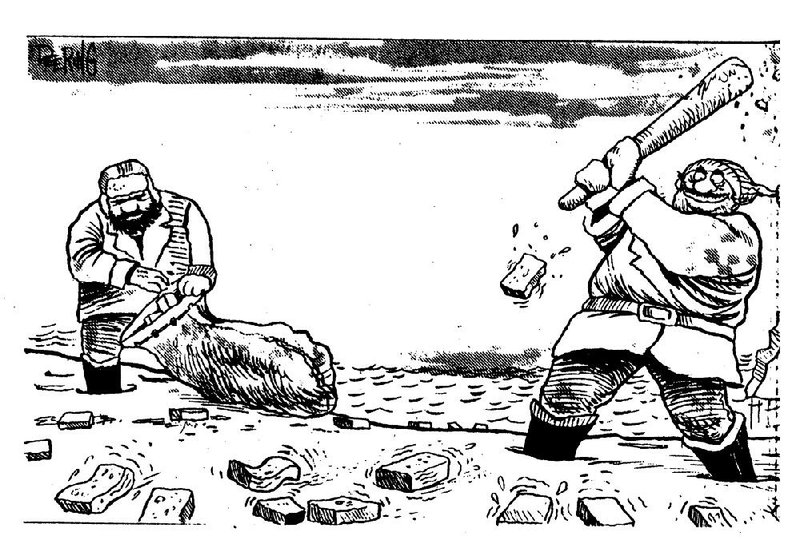Note: As has been our custom since 1984, the first Saturday following the autumnal equinox is set aside to remember the short, cruel lives of Spam. This year, fall arrived at 3:21 a.m. Wednesday and hearkened the annual holiday season, when Americans turn their thoughts to Spam.
"As I drove through the farming country of northern Missouri one evening last November," the letter read, "the night was blanketed with silence. Along my route just two places blazed with light. One was the white-framed Soul's Harbor Church of God in tiny Chillicothe where, through clear uncurtained windows, I saw a dozen worshippers joined in song. The other was the Spam rendering plant outside Hamilton."
On the one hand we have a traditional small town tableau wafting into the night from pews worn smooth by the faithful haunches of generations of village virtues or, as Jefferson termed them, "breeches of order rare."
On the other, a monument to cruel commercialism that caters to our basest, most craven communal gluttonous instincts -- cheap food, the cost of which includes our souls.
Thanks to the outcry from an outraged world, the days of the bloody Spam killing beaches are past -- when cruel men from the Spam trawlers would stride amid the placid Spam herds of Newfoundland. As I first wrote in 1984:
"The Spam hunters come with the first whispered wisps of autumn. Their faces are stone. Burly, strapping, dark and relentless, they wade ashore armed with oaken cudgels and carrying canvas sacks. Seeking only those young Spam still in their firm, pink, rectangular prime, the men bring their clubs down again and again and again ... "
Through the worldwide efforts of the United Nations Committee on Fur and Harp Spam, the slaughter on the Spam breeding grounds has abated. Except for the occasional poacher and the legal hunting allowed the native Beothuk, Mushuau, Miawpukek and Mi'kmaq tribes, this dark chapter in human history has ended.
Spokesmen for Hormel Foods Corp., the company that has marketed Spam commercially since 1937, once argued that without the annual "thinning" of the Spam herds, overpopulation and disease would mete out a far crueler fate than the swift dispatch of the Spam cudgel. This has not proved to be the case. Natural forces have kept the wild Spam population in check and the helpless babies, known as Spamettes, now look forward to growing up and living out their life spans without fear of slaughter.
Alas, such is not the case in America's heartland.
Following the international harvesting ban, Hormel created a network of domestic Spam farms that now stretch from northern Missouri through Iowa to its headquarters in Austin, Minn. The town, in the southeast corner of the state, proudly proclaims itself "Spam Town, USA."
These rambling complexes, such as the one near Hamilton, typically consist of 12 to 14 tin-roofed "Spam houses" each the size of a football field. Within these chambers of horror up to 300,000 Spamettes quiver in uncertainty awaiting their day of "harvesting."
Crammed together in unspeakable conditions, the Spamettes often turn on one another and their usual tranquil demeanor becomes ugly. Each morning on the Spam farms begins with crews wading through the shivering mass to "cull" Spamettes that have suffered abuse and become cosmetically unappealing. These unfortunate souls, many already dead or dying, are tossed unceremoniously into sacks and taken to an outbuilding where they are ground into pellets, mixed with assorted grains and rendered into Spam feed.
Yes, as repulsive as it may be, Spam are fattened and brought to the 12-ounce market weight by eating a mixture that contains up to 15 percent Spam and Spam byproducts.
To further disguise its offenses, Hormel has begun a series of nationwide recipe contests that feature such "delicacies" as Spambled egg muffins, Spam Musubi, Spamaroni and Spambalaya. On the market today is Spam Classic, Spam Jalapeno, low-sodium Spam and Spam Spread. Hormel even has a mascot, Sir Can-a-Lot, to make eating the meat more palatable to children.
Until next time, Kalaka reminds you that if you must consume Spam, please ignore the higher cost and consider the better taste and humane living conditions of family farm-raised "free-range" Spam.
Disclaimer
Fayetteville-born Otus the Head Cat's award-winning column of
Z humorous fabrication X
appears every Saturday. Email:
mstorey@arkansasonline.com
HomeStyle on 09/26/2015
